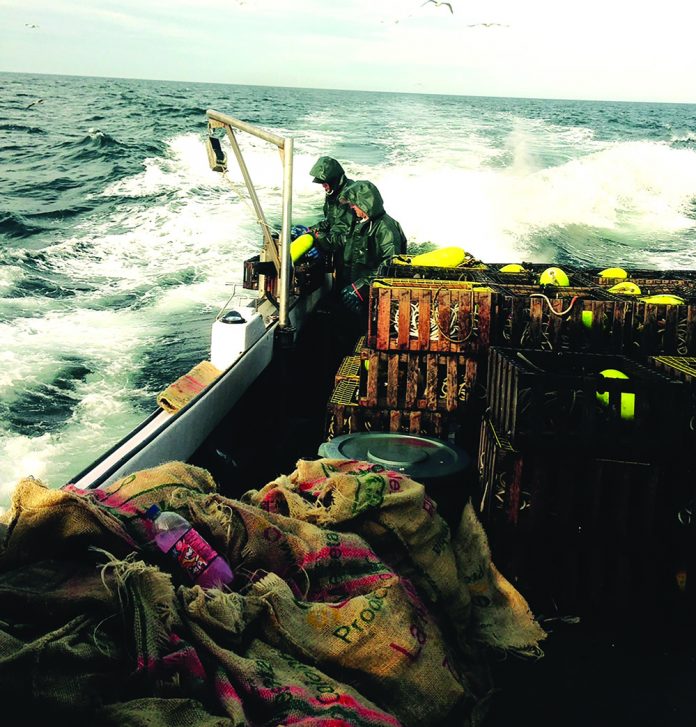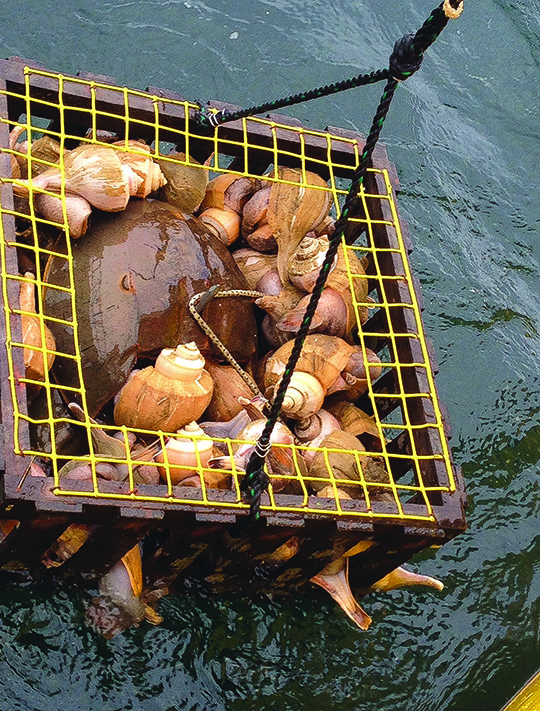
By Stefanie Jackson
A small group of Tangier watermen find themselves competing with Virginia’s biggest power company, Dominion Energy, for natural resources in an area just outside the Chesapeake Bay 27 miles off the coast of Virginia Beach.
Dominion Energy is using a 2,135-acre site in federal waters – leased by the Virginia Department of Mines, Minerals, and Energy – for its recently launched Coastal Virginia Offshore Wind Project, a two-turbine, offshore wind test site.
Each turbine produces about six megawatts of power.
The pilot project will prepare Dominion for 2024, when it plans to begin constructing 188 commercial offshore wind turbines that will produce about 14 megawatts of energy each – or more than 2,600 megawatts.
The offshore wind project is part of a goal for Dominion’s Virginia operations to be 100% carbon-free by 2045, as required by the Virginia Clean Economy Act, signed into law by Gov. Ralph Northam in April.
But even in the testing phase, the offshore wind project is interfering with the livelihood of watermen who have had much success in the area fishing for conch and black sea bass.
Todd Janeski, Virginia Coastal Zone Management Program ocean planning stakeholder engagement coordinator, has been facilitating meetings between Dominion Energy and the watermen with the goal of preserving the livelihoods of the Eastern Shore men and a decades-old way of life.
Tommy Eskridge, of Tangier, has been a conch fisherman for 25 years, since his son was three months old.
The conch is a shellfish known for its distinctive spiral shape that makes it popular with shell collectors.
The outer shells are used as landfill, but the conch is primarily used for food. Some of the conch Eskridge catches stays in the U.S., but most of it is shipped to Asia.
Conch has similarities to both clam and oyster, but it’s richer and more dense, pushing it a “step above” that makes for “very, very good food,” Eskridge said.
Conch can be steamed, fried, made into fritters, and cooked in a chowder, just like clams and oysters.
Eskridge’s favorite way to eat conch is right out of the cooker at the processing plant.
To say that conch fishing is hard work would be an understatement. On an average work day, Eskridge arises at 3:30 a.m., departs the dock at 4 a.m., and doesn’t return until 7 or 8 p.m.
He and his crew work together on a 42-foot deadrise boat with a forward cabin and open deck.

They catch the conch in pots, similar to crab pots but roughly half the size and less enclosed. The conch are caught when they climb up the pot and fall through the opening at the top. They are baited by horseshoe crabs and dogfish heads (the heads of spiny dogfish, a type of shark).
Eskridge, his son, Thomas Reed Eskridge, and his cousin, James Eskridge, each put out 1,000 pots and work 500 of them per day. They let each pot “soak” for 48 hours to get maximum use out of the expensive bait.
Tommy Eskridge catches blue crabs when conch are out of season. The conch are always there, but they don’t come out of hiding until they’re done molting for the summer and the mating season is over.
Late fall to late spring is the time for conch to fatten up. The conch fishing season runs from November or December to May or sometimes June, Eskridge said.
An average day’s work will yield 1,500 to 2,000 pounds of conch in the shell, but a “hot spot” once yielded 7,200 pounds of conch in one day.
In 2014, the hot spot provided 90% of Eskridge’s conch catch for the winter.
That hot spot is in the Virginia Wind Energy Area where Dominion plans to build its commercial wind turbines.
The 10-mile wide and 15-mile long area where the wind turbines will be built is also used for catching black sea bass and includes the Triangle Wrecks, which are popular with all types of fishermen.
The offshore wind project, in its early stages, is already causing trouble for black sea bass fishermen, whose property, such as buoys, has been damaged by vessels working on the Dominion project.
Conch fishermen are concerned about the impacts of the wind farm once the Dominion project is complete in 2026 and all the turbines are in operation.
One particular concern is electromagnetic fields surrounding the operating wind turbines and equipment.
Electromagnetic fields, or EMFs, are “invisible areas of energy” often referred to as radiation, associated with the use of electrical power and light, according to the National Institute of Environmental Health Sciences.
Eskridge is concerned that wind turbine EMFs could negatively affect the conch that bury themselves in the sandy, muddy bottom of the Chesapeake Bay.
The wind turbines will connect to nine cables that also will be buried at the bottom of the bay, about two meters deep.
No trenches are dug to bury the cables; instead, a method called jet plowing is used, which blows back sediment as the cable is laid.
The cables will lead directly to Virginia Beach, connecting to three substations along the way.
Dominion representatives told watermen during an Oct. 20 meeting that the EMF from a cable would be comparable to that of a “toaster oven.”
That assurance did not appear to instill confidence in the fishermen, who questioned how that comparison was determined and whether even a small EMF could negatively affect a conch.
No scientific study has been -done specifically on the effects of EMFs on conch. The most relevant study involved the effects of EMFs on sturgeon, which was compiled by Janeski and can be found on the Virginia Department of Environmental Quality website.
Dominion representatives stated that one goal of their meetings with local fishermen is to determine what additional studies must be done to inform the ongoing planning phase of the wind turbine construction project.
Dominion is considering the Virginia Institute of Marine Science as a research partner, which would solicit input from watermen.
The basic layout of the offshore wind site is done, but small adjustments, or “micrositing,” is possible, since construction won’t begin for four years and the project is currently in the preliminary design phase.
Kevin Carroll, of Dominion Energy, told the watermen the offshore wind project will proceed “with respect to what you do.”
He said “this is going to be good for Virginia” but acknowledged Dominion’s responsibility for the farther-reaching impacts of its project.
Lane Johnston, programs manager for the Responsible Offshore Development Alliance, a fishing industry coalition, also attended the Oct. 20 meeting.
She followed up with a Nov. 4 letter addressed to the meeting’s leaders, Kevin Carroll, Lloyd Eley, and Scott Lawton, all of Dominion Energy, and Ron Larsen, of Sea Risk Solutions, a marine risk mitigation company.
She wrote on behalf of captains Tommy Eskridge, James Eskridge, Thomas-Reed Eskridge, Spencer Headley, Mark Hodges, Art Hodges, and Kenneth Hodges.
Their requests include limiting construction to seasons when fishing will be minimally impacted, involvement in cooperative research, specific inclusion of black sea bass and conch pot fisheries in Dominion’s Construction and Operations Plan, and plans to compensate the fishermen for losses due to area closures and catch reductions.
The watermen’s work is challenging enough with “Mother Nature” as their only adversary, and Eskridge worries that the addition of the wind turbines will be “devastating.”
He will continue to fight for the preservation of the watermen’s livelihoods, but he wasn’t talking about the tides when he said, “there’s so much against us.”


